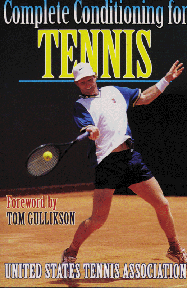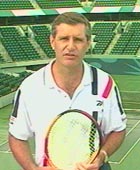Periodization Training for Tennis
Part 15
By Dr. Paul Roetert
More Quickness and Agility Drills
Tennis matches are made up of a long series of short energy bursts, up to 500 in a single match. An average point lasts 5 to 10 seconds, with up to 5 sudden changes in direction.
Because matches elevate your heart rate for an extended period, tennis is an aerobic sport. But the explosive nature of the points themselves are anaerobic, and this requires an entirely different energy system in the body.
A key aspect of periodization training then, is doing anaerobic exercises - drills that mimic the patterns of movement in matches, training your anaerobic system so you can burst to the ball, execute a high level stroke, change directions, and then burst again.
In the last article we outlined 4 anerobic on court movement exercises. This article adds 4 more, part of our complete periodization training program for tennis.
These drills will improve your quickness, your agility, your ability to get to difficult balls, and your balance. They will also allow you to sustain a high quality of stroke production over the course of a long match. Generally, they should be done at the end of a practice session.
The next three articles will provide on court anaerobic drills using rackets and balls.
In the final articles in this series I'll show you how to combine these drills with all the other elements in our system - the warm up, stretching, weight training, and aerobic conditioning - into a personal periodization training schedule that can raise your game a level and help you peak at the right times for competition.
 |
Cone Exchange
Purpose: This drill develops a quick first step and the ability to change directions quickly.
Drill: Start on the baseline. Pick up one cone, sprint to the service line and exchange the cones. Now sprint back to the baseline and repeat the exchange. Repeat for 30 seconds and count the number of pick ups.
 |
Lateral Direction Exchange
Purpose: This drill improves your quickness in changing directions, similar to the movement during a baseline rally.
Drill: All players face the coach. Shuffle sideways until the coach signals the direction change by calling out or pointing. Simulate a long point by following this pattern of changes for 10 to 20 seconds.
 |
The Wheel
Purpose: This drill simulates sprinting for a ball followed by a direction change.
Drill: The players sprint from the corner of the baseline to the cone, then to the far baseline corner, then back to the cone. Now he sprints to the right corner of the net and back to the cone. Next to the left corner of the net and back to the cone. Finally he sprints back to the same baseline corner where they started.
 |
X-Drill
Purpose: This drill has multiple direction changes and movement patterns that simulate the patterns in points.
Drill: The player shuffles along the baseline, then sprints diagonally across the court to the net post. Now the player shuffles along the net to the other net post, then turns and sprints diagonally back to the starting point.





